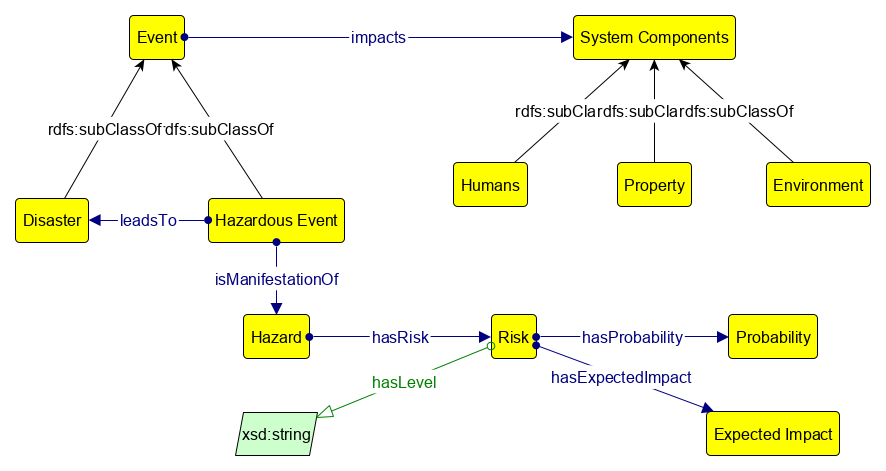INGENIOUS Ontology: Risk and disaster management to assist First Responders
During an incident, threats and hazards are unpredictable variables that may increase, decrease and evolve over time and space, constituting a ubiquitous danger for responders and civilians caught in the scene. The INGENIOUS ontology focuses on the modelling of the disaster, the wearable toolkits and their sensors, and information about the status of the First Responders, fostering advanced situational awareness and decision making capabilities.
Representing main Disaster entities
The following figure shows the core model for the description of disasters in a high level of abstraction. In detail, some hazards are sources of potential harm and have an associated risk that aims to quantify their potential harm. The hazards might be manifested by an event (Hazardous Event) which will introduce the hazard to the system thus causing the Disaster. Both Hazardous Events and Disasters are probable to affect (impact) some System Components, such as human resources, property assets and environmental assets.

Representing Vital Signs and Physiological Conditions of FRs
The condition of the first responders is very useful information towards their management and making sure they do not experience unecessary risks. There are multiple different sensors in INGENIOUS that measure vital signs of the FRs, and components that analyze the sensor reading in order to produce higher level information about the subject. In terms of the ontology, the class Vital Sign represents the raw data about the Person (e.g. Heart Rate, Blood Oxygen, and Body Temperature. The class Physiological Condition represents a more complex condition of the person that requires some analysis on raw sensor measurements to be produced (e.g. Dehydration, Assymetric Walking, and Tiredness).

Representing Sensor Measurements and Rolling Average
First responders are enhanced with the usage of smart wearable equipment that monitor their condition. The wearable equipment includes sensors, which produce raw data about the condition of the FR that wears the equipment. The data from the sensors is extremely important towards monitoring the overall condition of the FRs and is significant in the Expert Reasoning processes. Personal Equipment is subdivided into three categories: Smart Helmet, Smart Uniform and Smart Boots.

Representing First Responders and Operational Goals
The following figure shows the model about the First Responders, in the context of their structure and the correspondence to Operational Goals. This hierarchy schema allows for definition of flexible and heterogeneous team structures. The teams can be specialized in teams that are more specific according to the subclasses. This is important for the allocation of available FR teams to particular events (Disaster and Hazardous Events).

The INGENIOUS ontology is expressed in OWL 2. For its development and deployment, we relied on the following tools:
- Protégé-OWL v5.0, the popular ontology development environment;
- GraphDB for locally hosting test versions of the ontology;
- SPARQL served as the semantic query language for submitting queries to the ontology and running rules on top of the model;
License
Apache License 2.0
Related Projects
- ARESIBO
- INGENIOUS
- beAWARE
Ontologies (links)
https://drive.google.com/file/d/1M-RUdAIjczejkZA6w4hHcw69YR-JSYQV/view?usp=sharing
Contact
- Alexandros Koufakis: akoufakis@iti.gr
- Tasos Karakostas: akarakos@iti.gr
